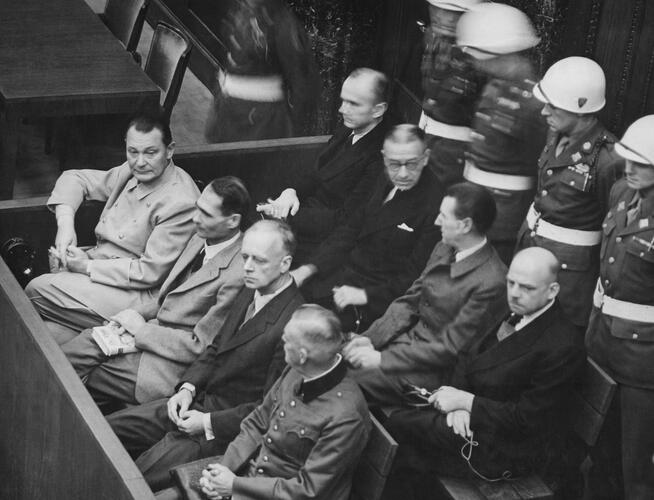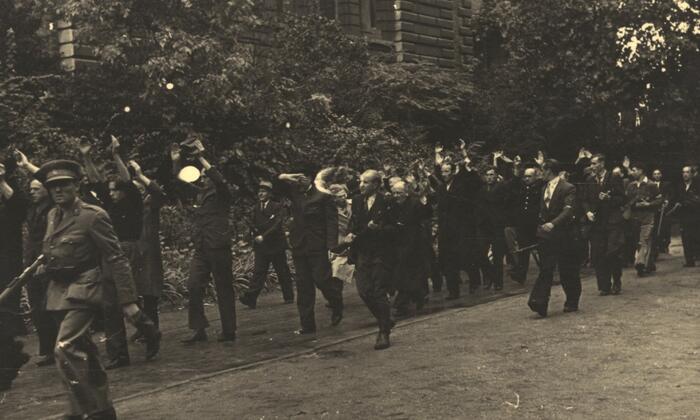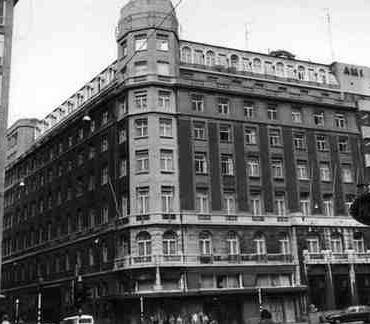The call for justice rang loud and clear in May 1945, as World War II gradually drew to a close in Europe. After five years of war, the people responsible and their accomplices had to be properly punished. The Nazi leadership and their local collaborators were all brought to justice. In November 1945, the Nuremberg Trials started in Germany, setting an example for all post-war trials. In Antwerp, meanwhile, the trials against German war criminals and local collaborators began soon after the liberation of the city in 1944.
The road to Nuremberg
While the war was still raging, the Allies reached a consensus on the conviction of the main protagonists in Nazi Germany after their much-anticipated victory. The first negotiations about the trials of German war criminals took place in 1942.
Nine European countries agreed to prosecute them by means of organised justice to avoid rash reprisals and executions.
On 20 October 1943, 17 Allied countries formed the United Nations War Crimes Commission, responsible for investigating the war crimes that had been committed by Nazi Germany. On 8 August 1945, soon after the capitulation of the Germans, France, Great Britain, the Soviet Union and the United States signed the Treaty of London. This provided for the creation of an international military tribunal which would be given the task of trying major war criminals. As there was no international legislation at the time, the legal framework for this court had to be established from scratch. The Nuremberg Charter stipulated the crimes that fell under the jurisdiction of the International Tribunal.
On 20 November 1945, the trials started in the Court House in Nuremberg. Twenty-four important political and military leaders were in the dock. They included the ringleader Hermann Göring, who was the Commander-in-Chief of the Luftwaffe and one of the most powerful figures in the Nazi Party. They all appeared before the International Military Tribunal, which consisted of judges and lawyers from various Allied countries. The charges included conspiracy, crimes against peace, crimes against humanity and war crimes. The allegations against them were serious, and so were the sentences. Twelve of the convicted criminals were sentenced to death. Three were sentenced to life in prison. The remaining criminals received lighter sentences. The executions took place on 15 October 1946, two weeks after the trial had ended.

Eight of the defendants during the Nuremberg Trials. Hermann Göring is sitting in the front left. (© Wikimedia Commons)
Trials in Antwerp
In Antwerp, (purported) collaborators were rounded up, arrested and interned during the liberation of the city on 4 September 1944. Initially this was a random, chaotic process. The Gendarmerie and the police were understaffed, which is why members of the resistance movement took the initiative instead. The authorities did everything possible to take control of events as soon as possible. From 19 September onwards, people were required to report collaborators to the police or the Gendarmerie but they could no longer arrest them themselves. The judiciary hoped to pre-empt any further action by the resistance groups with this rule.

One day after the Liberation of Antwerp. Resistance fighters after arresting a group of pro-German collaborators.
(© Antwerp City Archives)
The detainees awaited their trial in prison or in temporary internment centres.
The number of internees increased at such a rapid pace that these centres soon became overcrowded. This gave rise to horrific situations during the first months after the liberation. Almost half of the internees were imprisoned in the barracks of the Engineer Troops in Antwerp. Other large centres included the military barracks in Desguinlei and the Drubbel Barracks in Begijnenvest.
The Antwerp Military Tribunal
From 1942, the Belgian government in exile in London laid the groundwork for the post-war sentencing of collaborators and German war criminals. It relied on the legislation that its predecessor had drafted during World War I for this, adapting the laws to the current circumstances. Because the government feared that Belgium might be in a state of war for a long time after the liberation, it placed the responsibility for the trial of collaborators with the military tribunals. Unlike civil courts, these could continue to operate in wartime. The government therefore temporarily extended the powers of military jurisdiction between 1944 and 1946.
On 18 September 1944, the Belgian Official Gazette announced the establishment of a court martial and military commission in Antwerp. The military prosecutor led the investigation into the alleged crimes of the accused. Based on the evidence, he then decided whether the case would go to trial before a military tribunal, which took on the role of the court of first instance. The military prosecutor also had the option of proposing an out-of-court settlement or discontinuing the proceedings. The military tribunal of Antwerp was located at 1, Meir. At the end of September 1944, the first cases were heard. The proceedings got off to a difficult start. From the outset, the military tribunal was overwhelmed with cases. The personnel and resources needed to be urgently increased.

Office buildings of the Agence Maritime Internationale at 1, Meir. From September 1944 onwards, the buildings were used by the military tribunal. On 9 December 1944, a V-weapon fell on the building. (© Building Heritage Agency)
Military tribunal distinguish between four forms of collaboration: political, economic, military collaboration or denunciation.
To punish culprits, they relied on the existing criminal law, which the government further expanded in 1942 and 1944. The procedure followed by the military prosecutor changed several times during the post-war period. It was adapted ad how to process the stacks of case files of collaborators as quickly as possible. More than 405,000 files were started up all around Belgium between 1944 and 1949. In the majority of the cases, the military tribunal decides to discontinue proceedings. For approximately 53,000 of the accused, the investigation culminated in a conviction, with 2,940 criminals being sentenced to the death penalty, and another 2,340 receiving a life sentence.
The forgotten victims
A number of themes seem to have received more attention than others after the war. Both the public prosecutor's office and public opinion demanded severe punishments in cases that involved political prisoners and deported workers. The Breendonk collective trial, for example, was one of the most mediatised court cases during the post-war period. Twenty-three Flemish SS officers, workers and guards who run the Breendonk camp went on trial. By comparison, another group of victims was clearly underexposed, namely that of the Jewish deportees.
While this applied to Belgium as a whole, this was particularly evident in Antwerp.
In several cases involving Flemish SS officers, the military tribunal made very little of their involvement in the deportations. A number of important German leaders were also able to evade judicial proceedings. Erich Holm, the head of the Anti-Jewish section of the Sipo SD in Antwerp, was never arrested, for example. There were several reasons for this. After the war, Belgian legislation was not adapted to the Holocaust. As a result, military tribunals did not have the right legal framework for investigating the persecution of the Jews. During the first years after the war, there was also a lack of basic information about the Holocaust. Due to the low survival rate of deportees, there was also a lack of witnesses. The Germans also destroyed many important archives at the end of the war.
Antwerp stands out, however, because the investigation into the raids of 1942 was an extremely sensitive topic due to the involvement of the Antwerp police force and various high-ranking political figures, including wartime mayor Leo Delwaide, chief police commissioner Jozef De Potter and public prosecutor Edouard Baers. The investigation into the role of Antwerp’s police in the detention of Jews began in September 1944. A few months later, however, military prosecutor Herman Sabbe realises the far-reaching consequences of this case, which would compromise several high-ranking officials. In addition, De Potter, Baers and a large number of Antwerp police officers had joined the resistance during the last years of the war. They thus had the public on their side. This influenced Sabbe’s decision in November 1945 to halt the complex investigation.

